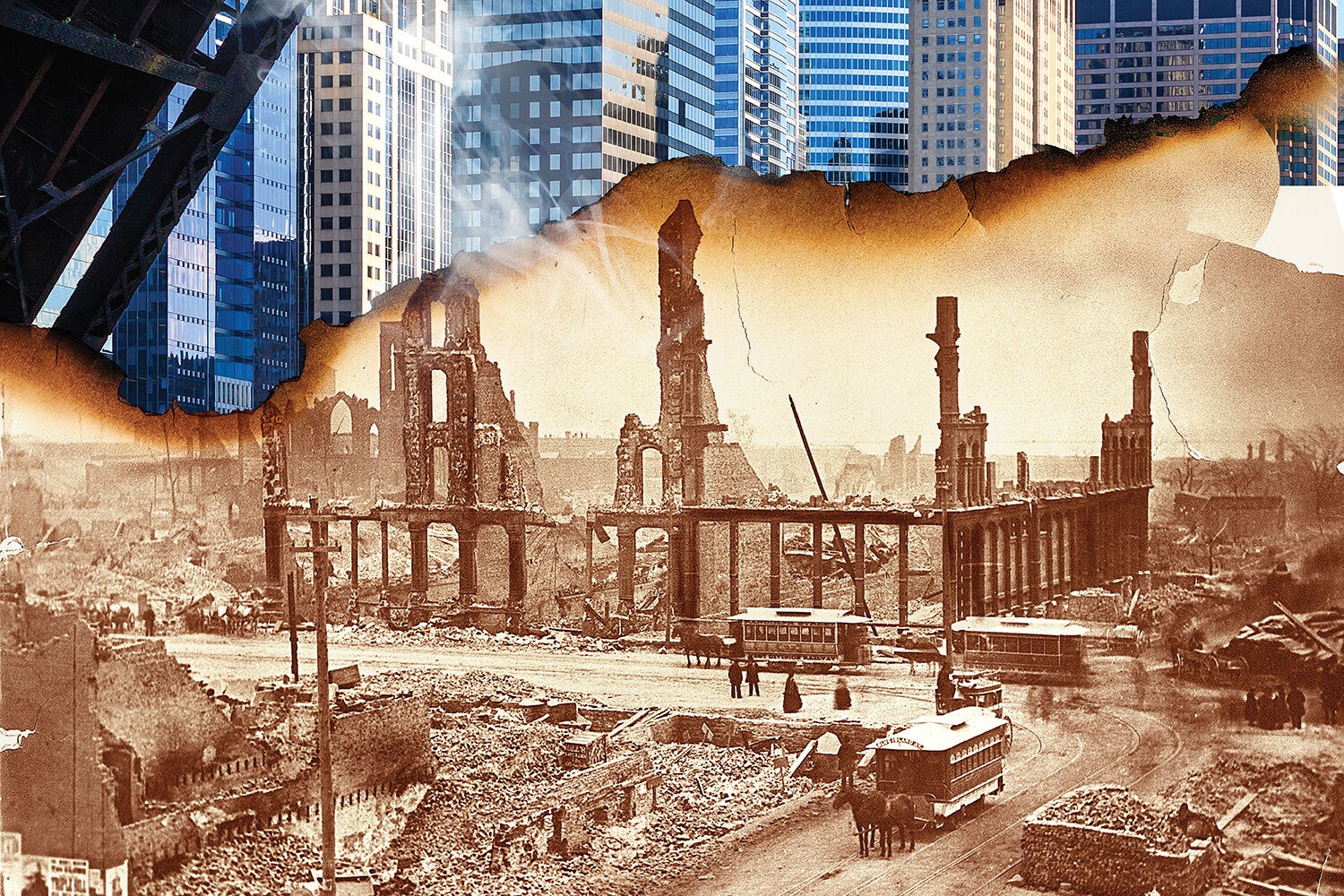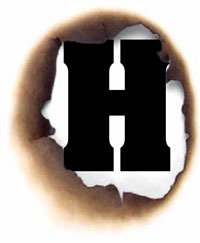 ardly any rain had fallen on Chicago for months, and the drought was getting worse. Over the 22 days leading up to October 8, 1871, it had rained only once — a measly 0.11 inches. “Under the burning sun for so many weeks, the whole city became virtually a tinderbox,” recalled William Bross, one of the Chicago Tribune’s owners.
ardly any rain had fallen on Chicago for months, and the drought was getting worse. Over the 22 days leading up to October 8, 1871, it had rained only once — a measly 0.11 inches. “Under the burning sun for so many weeks, the whole city became virtually a tinderbox,” recalled William Bross, one of the Chicago Tribune’s owners.
A mere 35 years earlier, Chicago had been a frontier outpost with a few thousand inhabitants, but now it was the commercial metropolis at the heart of the Midwest, growing at an astonishing pace as it drew people from around the country and from Europe, mostly German and Irish immigrants.
By 1870, it was the United States’ fifth-largest city, with a population of 300,000. And for the most part, it was made of wood. “Lumber was cheaper than brick and was more easily procured and more rapidly handled,” the Tribune would observe in 1872. “In a city where time was everything and durability was not a matter much considered, street after street was lined with wooden buildings.”
Forest and prairie fires were frequent in 1871 across a vast swath of the country’s northern regions, from the Rocky Mountains to upstate New York. During the first week of October, the Chicago Fire Department fought more than two dozen fires, wearing out the city’s approximately 190 firefighters and their horse-drawn equipment. They had 17 steam fire engines — three of which were out for repairs — along with four hook-and-ladder wagons and six carts that carried reels of fire hose.
Nearly the entire department spent the night of Saturday, October 7, battling a blaze that burned down four square blocks just west of the Chicago River’s South Branch and north of Van Buren Street. Many firefighters were still working at the smoldering site Sunday afternoon. Some had been on the job for 18 hours. “The men were exhausted, and some of the engines were in bad condition,” said Robert A. Williams, who’d been Chicago’s chief fire marshal since 1868. “The supply of hose was inefficient.” They’d barely had a chance to rest when another fire broke out Sunday night, in a barn half a mile south of Saturday night’s burning. After that, as firefighter Leo Meyers recalled, “everything went wrong.”
Over the next 30 hours, that fire would grow and grow, roaring across roughly three square miles in the heart of Chicago, killing hundreds of people and destroying 17,450 buildings — causing more property damage than any fire before it in America. As Chicago marks the disaster’s 150th anniversary, the fire remains the most famous event in the city’s history.
This is the story of the Great Chicago Fire, as told by people who lived through it. Their words are from letters, memoirs, oral histories, newspaper articles and books of the time, and testimony at a city inquiry in 1871 (which Richard F. Bales transcribed for his 2002 book on the fire and donated to the Chicago History Museum). The quotes have been lightly edited for clarity and length; language of the era has been left intact.
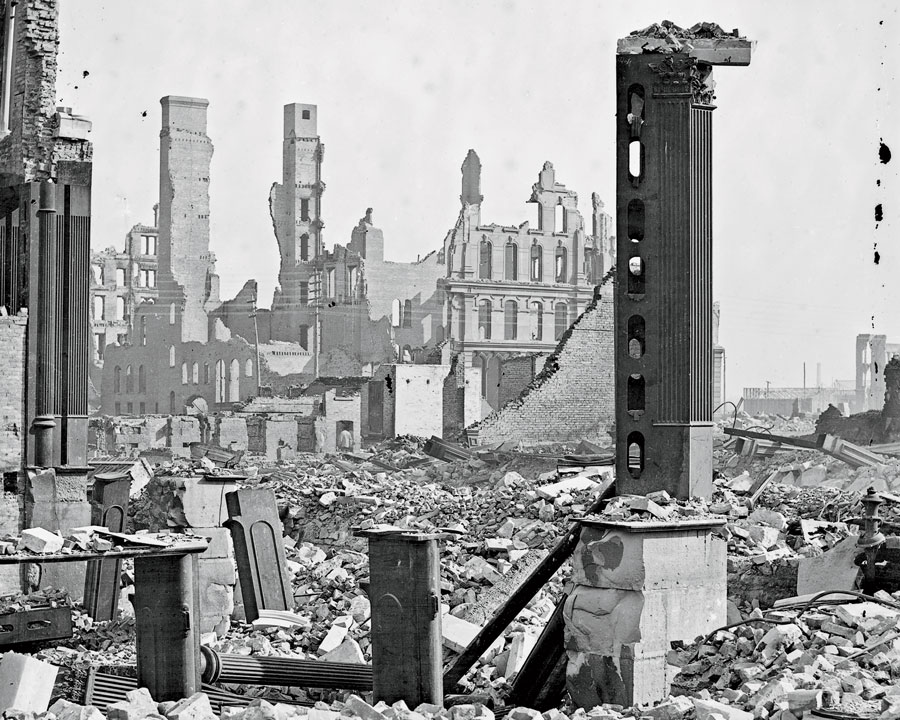
“Kate, the barn is afire!”
Patrick and Catherine O’Leary lived with their four children on DeKoven Street just east of Jefferson Street, an area where most of the residents were Irish or Bohemian. Now considered the South Loop, in 1871 this was part of the West Side or West Division — as the city designated all land west of the Chicago River’s branches.
Joseph Edgar Chamberlin, 20, was a Chicago Evening Post reporter.
Chamberlin: That neighborhood had always been a terra incognita to respectable Chicagoans, and during a residence of three years in the city I had never visited it. The land was thickly studded with one-story frame dwellings, cow stables, pig sties, corn cribs, sheds innumerable — every wretched building within four feet of its neighbor, and everything of wood. Not a brick or a stone in the whole area.
It’s uncertain precisely how old Patrick and Catherine were in 1871, because the U.S. census and other vital records are inconsistent, but most documents indicate they were in their 40s. They’d come from Ireland about two decades earlier, at the beginning of the Irish Potato Famine, and Patrick found work as a laborer. He bought the lot on DeKoven Street for $500 in 1864. Two adjoining cottages stood on the property: The O’Leary family lived in back, and rented out the other to the McLaughlins, who were also Irish immigrants. The O’Learys sold milk, keeping several cows and a horse in a barn at their property’s north end, along an alley.
Patrick and Catherine O’Leary’s son Jim, who was 8 years old, was interviewed as an adult about that week’s events.
Jim O’Leary: The day before the fire — it was a Saturday — I helped the old gent put in some timothy hay in the loft above the cow shed. My part of the job was to stamp it down in the mow. I thought it was great sport.
His sister Katie, who was 5 in 1871, spoke decades later about that Sunday evening.
Katie O’Leary: Mother had put me to bed with the other children at 8 o’clock. She went to bed, too, and father followed a half-hour later. It was a hot night, and the sun had been blistering for weeks.
That evening, Catharine McLaughlin, 36, and her husband hosted a party for a relative who’d just arrived from Ireland.
Catharine McLaughlin: There was a greenhorn brother of mine there. The cousins and neighbors of mine came in to see him. My husband played two times on the fiddle, that was all. There was one, a brother of mine and another lady danced a polka. That is all that was played.
Catherine O’Leary: I knew they were not in bed, because I could hear from my own bedroom. Could hear them going on. There was a little music there.
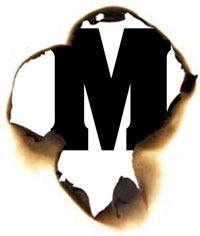 any stories were told about what happened next. Guests from the McLaughlin party supposedly entered the O’Leary barn and milked a cow, which kicked over a lantern. Or some men or boys went into the barn to drink, smoke, or gamble, or to hunt rats, inadvertently starting a fire. During an 1871 inquiry, the city’s Police and Fire Commission heard no testimony from anyone who’d been seen entering the barn, but that investigation was far from thorough. Daniel Sullivan, a 26-year-old Irish immigrant with a wooden leg, testified that he saw a fire in the barn around 9:20 or 9:25 p.m., when he was sitting on the other side of DeKoven Street.
any stories were told about what happened next. Guests from the McLaughlin party supposedly entered the O’Leary barn and milked a cow, which kicked over a lantern. Or some men or boys went into the barn to drink, smoke, or gamble, or to hunt rats, inadvertently starting a fire. During an 1871 inquiry, the city’s Police and Fire Commission heard no testimony from anyone who’d been seen entering the barn, but that investigation was far from thorough. Daniel Sullivan, a 26-year-old Irish immigrant with a wooden leg, testified that he saw a fire in the barn around 9:20 or 9:25 p.m., when he was sitting on the other side of DeKoven Street.
Sullivan: I got up and run across the street and kept hollering, “Fire, fire, fire!” I couldn’t run very quick. I could holler loud enough but could not run. At the time I passed O’Leary’s house, there was nobody stirring.
I made right straight in the barn. I made at the cows and loosened them as quick as I could. I got two of them loose, but the place was too hot. I had to run when I saw the cows were not getting out. The boards were wet, my legs slipped out from me, and I went down. I stood up again, and I was so close to the wall, I could hold onto something and made for the door. Just as I got to the door, there was a goddamned big calf come along, and the back of the calf was all afire, and Christ, I thought it was time I got out of the yard. I had hold of the calf by a rope. The calf was all burnt. I stood and looked back at the fire as a dog will look when he is licked with a rope.
Katie O’Leary: At 9:30 there was a pounding and bellowing at the back door. It was Sullivan, the one-legged drayman from next door. That’s the first we knew of the fire.
Sullivan: I was hollering and shoving in the door when [Patrick O’Leary] came out. He had nothing on but his pants and his shirt. He put up his hands and scratched his head, same’s he had a foot of lice in it. He went in and called his wife and she came out and just clapped her hands together.
Catherine O’Leary: My husband got outside the door and he ran back to the bedroom and said, “Kate, the barn is afire!”
Patrick O’Leary: I put the children in the street as fast as I could. [The fire] was lighting so strong when I got up.
Firefighters at three stations saw the flames and headed for DeKoven Street. Meanwhile, a watchman at Chicago’s downtown Court House spied the flames but gave the alarm system’s operator incorrect information about the location. Some firefighters later said this errant alarm around 9:30 p.m. delayed their response.
William Musham, 32, was foreman of the Little Giant engine.
Musham: When we reached the place, I found four or five barns burning on DeKoven Street, just east of Jefferson. I took the [hydrant] at the northeast corner of Jefferson and DeKoven streets, and the boys got to work. At that time, I did not consider the fire dangerous. It was a nasty fire, but not a particularly bad one — and with the help of two more engines we could have knocked it cold. But those engines didn’t come, and we had to fight it alone.
John J. McKenna was about 16 at the time.
McKenna: Myself and four young men followed the engine down DeKoven until we came to where the fire was. It was the O’Leary barn, and the top of it was going full blast with flames of fire. It was a small barn, at that. We thought it would be but a short job for the firemen to put it out, but the fire and sparks were rolling out.
Within that hour, the kids around Clinton and DeKoven Streets were relating about the cow kickin’ over the lamp and causing the fire.
George Leady, 25, was a firefighter with the Frank Sherman engine.
Leady: The fellows who were around while we were fighting the fire that night said the thing had started because of someone’s cigar or pipe ashes catching fire to the hay in the barn.
Jim O’Leary: The origin of the blaze was spontaneous combustion of green hay. I’ll give odds of 1,000 to 1 that I can prove it.
Dad had put in a load of partly cured hay, and its heat started the fire. They say that when green hay sweats it causes spontaneous combustion, and that, I heard the old gent often say, was the cause of the fire starting in our cow shed. I don’t know any more about it than that, and I don’t think anybody else does.
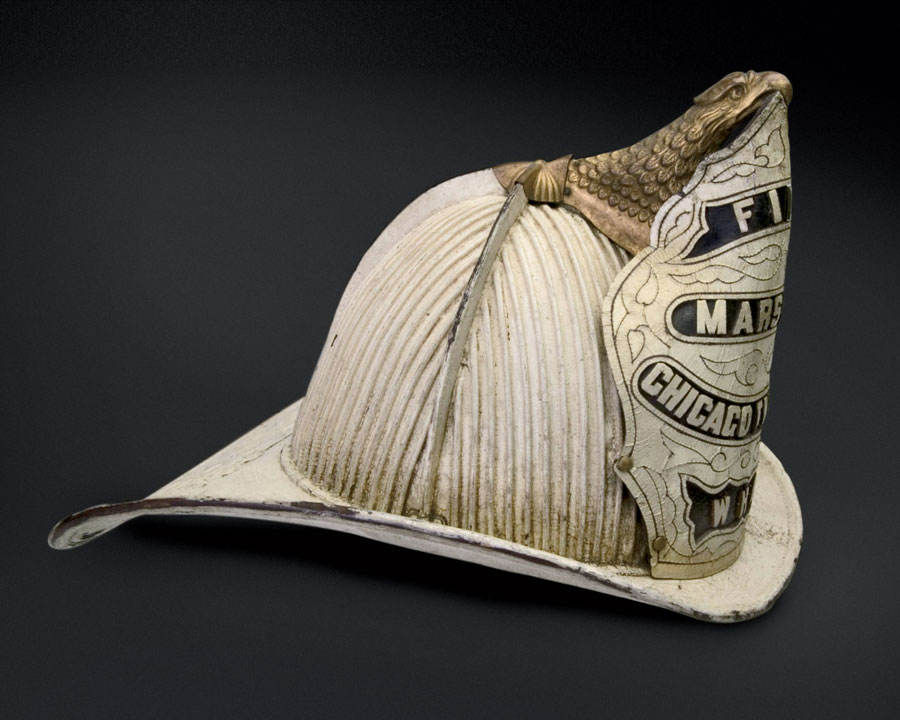
“Everything was as it should not be.”
The fire spread to Taylor Street, one block north of DeKoven, as more companies of firefighters arrived, along with the fire marshal, 41-year-old Robert A. Williams.
Williams: There was a regular nest of fire. Said I, “Hang on to her, boys; she is gaining on us.”
Musham: It was too much for us. The fire spread and got into the cottages east of O’Leary’s, crossed the alley, and pushed its way into the buildings fronting north on Taylor Street. A severe breeze sprang up, increasing the peril.
David Kenyon, 35, was a firefighter with the Chicago fire engine.
Kenyon: It was so hot that the horse could not stand it.
Charles Anderson was the driver of the America hose cart.
Anderson: My clothes began to smoke and my hat began to twist on my head, and Williams said, “Come out as fast as possible and wet the other side of the street, or it will burn.” I happened to cast my eye up and saw the buildings all on fire.
Christopher Schimmels, 26, was the foreman of the Chicago fire engine.
Schimmels: We hadn’t [sprayed water] five minutes before she [the engine] gave out. I got back there and asked the engineer what was the trouble. He said there was one of the springs broke in the pumps. Said I, “Is it going to do her any hurt to run her?” Said he, “I do not know. It is running a big risk. I might smash that pump all to pieces.” Said I, “This is going to be a big fire. Smash her! We have got to run her.” He started her up, and she run first rate.
Mathias Benner, 33, was the third assistant fire marshal.
Benner: I hate to say things unpleasant to anybody. But if the Chicago had done her duty, the flames would have been checked at Taylor Street. The engine had no steam on when she left her quarters and could do nothing when she reached the fire. When the company returned from the Saturday night fire, they were utterly exhausted, and when they housed their engine and cart, they dragged themselves to their bunkroom. The captain went home. The slumber of the men was shortly broken by the alarm for the big fire, and they were, indeed, caught napping. Their engine was uncleaned after her rough experience; there was no fire in the fire box; everything was as it should not be.
German immigrant John Schank, 41, was the first assistant fire marshal.
Schank: I got round on DeKoven Street, and there met Williams. I saw how things were and said to him, “Chief, you’ve got to bring those engines ahead of the fire toward Polk Street, or else we’ll burn up the whole town.” He said, “It can’t be done. If we try that, the fire’ll work back on us.” Well, I said, “All right.” But I saw how it would be.
Williams: I did not see Schank during the whole fire. I do not know where he was.
Schank: It’s a damned lie. If the engines had been brought to lead the fire 15 or 20 minutes earlier, we could have stopped it easily.
Two blocks north of the blaze, the steeple of St. Paul’s Catholic Church caught on fire around 10 p.m., ignited by cinders carried by the wind. As the church burned down, the fire spread to other buildings in the same block: a lumberyard, factories filled with matches and shingles, and Alderman William B. Bateham’s wood-planing mill.
Thomas D. Foster, 24, who’d come to Chicago from Ontario to establish a meatpacking plant, had watched the previous night’s fire. Now he witnessed the new conflagration.
Foster: It was a grand sight but hellish in the extreme; streets, houses, trees, and everything in one grand furnace. It was not a blaze like the night before, but a white melting heat. Volumes of flames were cut off from the seat of the fire itself and carried over into other streets. There was a perfect shower of sparks, all red and glowing. The fall of them was like a fall of golden snow, and as far as the eye could reach upward, the air was filled with them; not only sparks, but burning brands of wood from six inches to two feet long, and from one inch thick to six inches. This may seem incredible but it is true. I saw them myself, saw them fall in the street, and worse than that, on houses with wooden roofs, and on people’s heads, almost knocking them down. The wind was blowing a fearful gale at this time and that accounts for it.
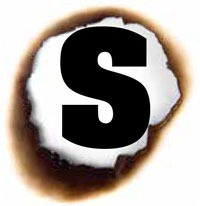 preading east of Canal Street, the fire reached the Chicago River’s South Branch. Martin Stamm, 31, an immigrant from Switzerland, had just moved to Chicago, becoming the pastor at First Evangelical Church on Clark Street between Van Buren and Polk. When Stamm heard the alarms, he walked west across the Polk Street bridge to see the fire.
preading east of Canal Street, the fire reached the Chicago River’s South Branch. Martin Stamm, 31, an immigrant from Switzerland, had just moved to Chicago, becoming the pastor at First Evangelical Church on Clark Street between Van Buren and Polk. When Stamm heard the alarms, he walked west across the Polk Street bridge to see the fire.
Stamm: I turned northward and ran upon the tracks of the Pittsburgh and Fort Wayne Railroad in the lumber district, where immense quantities of lumber had been stacked on the riverbank for sale. Suddenly I felt the contact of a wave of the superheated air. I faced about with lightning speed and ran. I hurried onto the bridge to save my own life with the help of God. Everything was a pandemonium of pushing, striking, raging forward, cursing, howling in fury and madness. I was pushed, crushed, struck at!
Looking east across the river, firefighter Alexander McMonagle saw some flames in the downtown area — which at that time was part of Chicago’s South Division, commonly called the South Side.
McMonagle: The wind was blowing a severe gale at the time. The chances are the wind carried the sparks over there.
McMonagle hurried over to tell the fire marshal what he’d seen.
Williams: Alec said, “Robert, the fire is on the South Side.” Said I, “The devil it is.” Said he, “You look.” I did. Said I, “Go for it. I’ll be there in a minute. You go to work.”
Chamberlin, the Evening Post reporter, was watching some firefighters at work on the West Side.
Chamberlin: Suddenly the horses were attached to the engine, and, as soon as the hose was reeled, it disappeared, whirling northward on Jefferson Street. What did it mean? I caught the words “across the river” uttered doubtingly by a bystander. The words passed from mouth to mouth, and there was universal incredulity. There was a general movement northward. I went with the rest, crossed the burnt ground of the night before, stood on the embankment that had been Canal Street, and perceived, through the clouds of smoke, a bright light across the river.
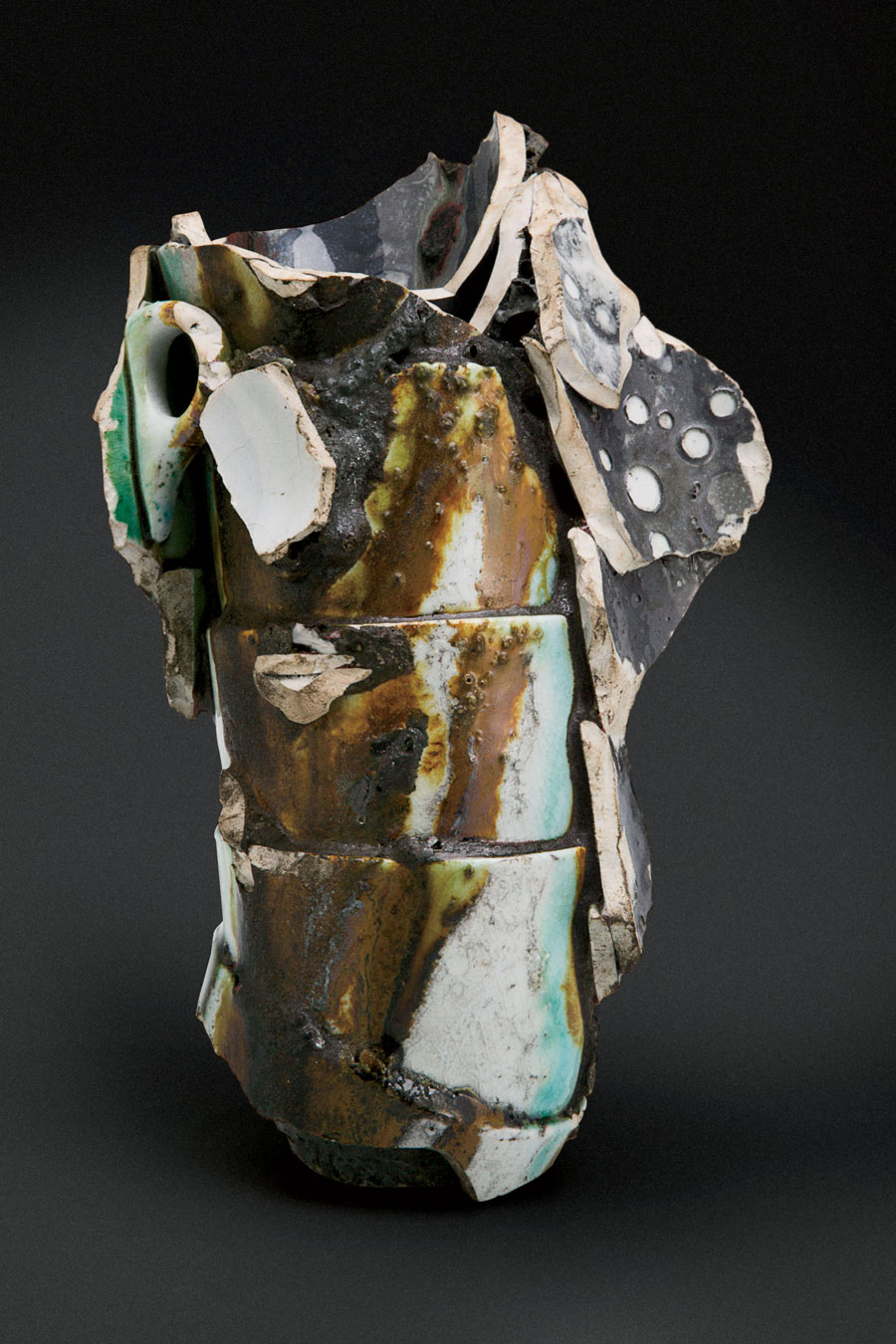
“At that moment, the fire was master.”
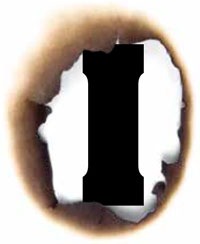 t was about midnight. In downtown, the fire had struck first near the Chicago Gas Light and Coke Company’s plant, between Adams and Monroe Streets near the river, and then it quickly engulfed a nearby roofing factory.
t was about midnight. In downtown, the fire had struck first near the Chicago Gas Light and Coke Company’s plant, between Adams and Monroe Streets near the river, and then it quickly engulfed a nearby roofing factory.
Thomas Ockerby, 32, was the night superintendent at the gas works.
Ockerby: I saw a fire brand coming over to where I was. It was a shingle all alight with fire. I could see the fire brand drop down. A sheet of fire and smoke rushed right up.
Williams: The roofing material yard, together with the gas works, threw out a terrific heat. Large fire brands, composed of tar and pitch felting, some two or three feet in length, were whirled through the air for a number of blocks, and would alight on some building, and hardly a minute would elapse before the whole structure would be involved in one mass of fire.
The flames spread into Conley’s Patch, a poor Irish neighborhood clustered around Jackson and Wells Streets.
McKenna: It looked like an old border town — Wild West. It went up like a matchbox.
Lawyer Chalkley Hambleton, 43, was nearby.
Hambleton: The many old frame buildings in that vicinity were all ablaze, and the streets were filled with women and children in their nightclothes and men with bundles and clothing in their arms fleeing from the flames.
Irish immigrant Michael C. Hickey, 45, was a police captain.
Hickey: There was such confusion! The streets were just perfectly thronged with these human beings trying to get out of these patches, and they were all hollering and running in every direction.
Western Union Telegraph bookkeeper Frank Loesch, 19, helped people in Conley’s Patch carry belongings from their homes — and then told them to run for their lives. Hurrying north on Wells, he saw some men ramming open whiskey barrels that were lying in the street.
Loesch: As soon as the liquor was gushing out, the men would throw themselves flat into the street to gulp the whiskey as it poured over them. No one interfered with their amusement.
Williams: I rallied the greater part of my force to the South Side, but it was of no avail. The wind blew so hard at this period as to cut a solid stream of water into spray before it had gone the distance of 20 feet from the pipe. The fire made such rapid headway that we were constantly compelled to move some of our steamers [fire engines] to save them from destruction, and by so doing lost large quantities of our hose.
The U.S. government’s weather office reported that “toward 1 a.m. the heat of the fire had become so intense as greatly to increase the power of the wind in the immediate neighborhood of the flames.” The observer noted a counterclockwise “whirling motion in the column of flame and smoke.” Around this time, flames engulfed the five-story Oriental Building on LaSalle Street between Washington and Madison.
Williams: At that moment, the fire was master. It was there, if anywhere, that it seemed to be superhuman and bent on its work of destruction. A wave of wind met the sea of fire, and the sea of fire rolled over the Oriental Building.
Foster had returned to the hotel where he was staying, the Briggs House at Randolph and Wells Streets.
Foster: I walked out to see the progress of the fire. It had taken full possession of the fine buildings. It was surprising to see the way they tumbled. Marble buildings cracked away for a time, then burst out in a volume of flame. The walls parted, and down came the whole fabrication, a jumbled mass of smoldering ruins.
Hickey: There was nothing could stop it but Providence alone. After it got so furious, there was no handling of it. I have seen men taken at the corner of Clark and Randolph Street, and the wind would take them 50 feet before they could get on their feet. You could not stand the heat. The wind would burn your face. The wind grew stronger around that corner.
Williams: In a second, it seemed to me, I turned around. The Chamber of Commerce, on the corner of Washington and LaSalle Streets, was on fire. The Court House was on fire. It seemed to me that everything was on fire.
The Court House was the headquarters for the Cook County and city governments, standing in the block bounded by Randolph, LaSalle, Washington, and Clark Streets (the same spot where the County Building and City Hall are today). Alexander Frear, 51, a New York State Assembly member, was staying across the street, at the Sherman House (where the Thompson Center is now).
Frear: The guests of the house were running about wildly, some of them dragging their trunks to the stairway. I looked out of one of the south windows of the house and shall never forget the terribly magnificent sight I saw. The Court House park was filled with people, who appeared to be huddled together in a solid mass, helpless and astounded. The whole air was filled with the falling cinders, and it looked like a snowstorm lit by colored fire.
Ed Longley, a deputy sheriff, was in charge of a jail in the Court House.
Longley: I got an order from Mayor [Roswell B.] Mason: “Release all prisoners from the jail at once, keeping them in custody if possible.” The policemen came in. I unlocked the cells of the murderers and delivered them to the officers.
I opened all of the cell doors, and let the men into the corridors. They were all perfectly wild, and yelled as if they were exercising their lungs for the last time — running hither and thither, as if they did not know what to do. It was the greatest excitement I ever saw.
Loesch was nearby, watching the Court House burn while a bell rang in the building’s tower. Chamberlin was also watching.
Loesch: Above all the sounds of the roaring fire, the wind, and the excited shouts of a moving mass of people, the bell whirled on its frame and over its stanchions, ringing out with a weirdness and a despairing clangorous volume, as though it were possessed of sense and were agonizing in its struggle against destruction. The east and west wings of the Court House were constructed of Joliet limestone. The strong southwest wind was driving the heat in sheets of flame from the hundreds of burning buildings to the west of it, upon the southwest corner of the building, with such terrific effect that the limestone was melting and was running down the face of the building with first a slow then an accelerating movement, as if it were a thin white paste.
Chamberlin: The great tower fell to the bottom with a dull sound and a heavy shock that shook the earth. Somebody called out, “Explosion!” and a panic ensued, in which everything and everybody was carried westward.
Hickey: The howling of the wind, the hallooing of people, and screaming was the most horrible thing that ever I heard in my life or anybody else will ever hear. You could not hear yourself with the howl of the wind and the howling of the flames.
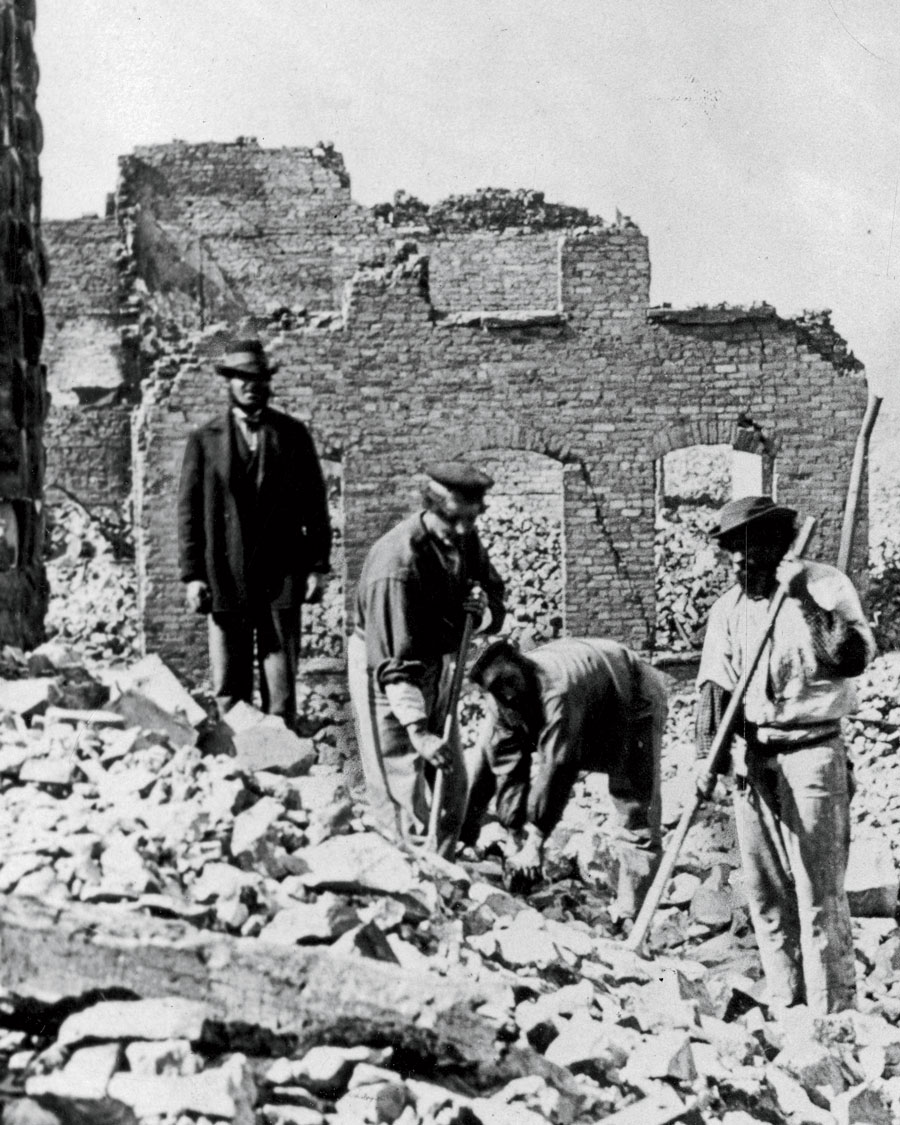
“People were carrying all kinds of crazy things.”
Juniata “Nannie” Stafford, 16, was awakened during the night at her family’s downtown home, on Michigan Avenue near Madison Street.
Stafford: When I got up, the sky looked all as if it were on fire, people were rushing from all directions toward the lakeshore, some dragging trunks, some with bundles on their backs, and all with terrified looks. One poor woman with only a night dress on, with her husband who had in his arms a babe only a few days old, came into our yard for protection. Our yard was filled with people with trunks, bags, boxes, etc. Oh! It was fearful. Men cursing and swearing, women crying and asking God to have mercy, strong men weak and the weak strong.
A 19-year-old peddler who’d immigrated from Russia in 1870 was living downtown with his aunt and uncle’s family on Fourth Avenue (now Federal Street), sharing a bed with two roomers.
Peddler: My two bedfellows were shaking me. “Get up,” they cried. “The whole city is on fire! Save your things!” I jumped out of bed and pulled on my pants. Everybody in the house was trying to save as much as possible. I tied my clothes in a sheet. With my clothes under my arm and my pack on my back, I left the house with the rest of the family. Everybody was running north. People were carrying all kinds of crazy things. A woman was carrying a pot of soup, which was spilling all over her dress. People were carrying cats, dogs, and goats. In the great excitement, people saved worthless things and left behind good things.
Frear: Lake Street was rich with treasure, and hordes of thieves forced their way into the stores and flung out the merchandise to their fellows in the street, who received it without disguise, and fought over it openly.
I went through to Wabash Avenue, and here the thoroughfare was utterly choked with all manner of goods and people. Valuable oil paintings, books, pet animals, musical instruments, toys, mirrors, and bedding were trampled underfoot. Goods from the stores had been hauled out and had taken fire. And the crowd, breaking into a liquor establishment, were yelling with the fury of demons, as they brandished Champagne and brandy bottles.
The brutality and horror of the scene made it sickening. A fellow standing on a piano declared that the fire was the friend of the poor man. He wanted everybody to help himself to the best liquor he could get, and continued to yell from the piano until someone as drunk as himself flung a bottle at him and knocked him off it.
In this chaos were hundreds of children, wailing and crying for their parents. One little girl I saw, whose golden hair was afire. She ran screaming past me, and somebody threw a glass of liquor upon her, which flared up and covered her with a blue flame.
Some Chicagoans had rushed downtown to retrieve money and precious items from their offices. Joseph Hudlun, an African American who’d been born in slavery in Virginia, went to the Chicago Board of Trade, where he worked as the head janitor, and saved valuable papers from the vault. John Shortall rescued his company’s abstracts of Chicago property records. Henry Nash, a government cashier, packed up currency at the U.S. Depository. Alonzo Hannis sorted mail at the post office until the building was in imminent danger. After running outside, he found a bag of mail lying in the street. He would spend the next day hauling it around with him, guarding over it.
Hannis: All this time, the wind was blowing a perfect hurricane — sand and fire. My face was black while my eyes were red with bloodshot.
Adin Swan, 19, went with his uncle Charles Day to their family’s stove business, Jewett & Root, on River Street (now Wacker Drive) near Michigan Avenue. The building was on fire as they went inside to retrieve some of Day’s papers from a safe.
Swan: I took off my coat and doused it in the river. I threw water all over him and myself and after being thoroughly damp we started. I believe that wetting our clothes was the only thing that saved us, for we passed through fire for 10 feet. My boots were burned to a crisp, and I found myself barefooted when I got back to the store.
We ran the gauntlet, and getting to the safe, I opened it and found the packet of papers we had risked our precious necks for. I put it in my bosom. By the time we got out of the store, my overcoat was burning. We were all surrounded by fire.
Two of our neighbors who entered the building about the time we did are missing. Burnt to death, beyond a doubt. We left them near our store, and the last we saw of them, they stood wringing their hands. I thanked God on my bended knees that we was spared.
“My God!
The waterworks are afire!”
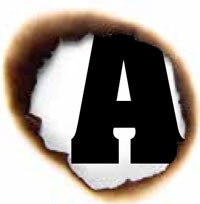 round 1:30 a.m., while the Court House was burning downtown, fires broke out as far as a mile north of the main fire — apparently sparked by flaming material blowing in the wind. After 2 a.m., fire reached the Chicago Water Tower and Pumping Station. Built in the 1860s, the waterworks were north of Chicago Avenue along Pine Street (now North Michigan Avenue), where they still stand today.
round 1:30 a.m., while the Court House was burning downtown, fires broke out as far as a mile north of the main fire — apparently sparked by flaming material blowing in the wind. After 2 a.m., fire reached the Chicago Water Tower and Pumping Station. Built in the 1860s, the waterworks were north of Chicago Avenue along Pine Street (now North Michigan Avenue), where they still stand today.
Gilbert D. Merrill, 19, a Western Union telegraph operator, was accompanied that night by two companions.
Merill: We looked to the north of us, and to our amazement found there was another fire near the waterworks. People became almost crazed at this, running hither and thither, hollering, “My God! The waterworks are afire! What will we do for water?” I thought my blood would freeze. The chills went through me so fast.
Williams: I was told that the waterworks were on fire. I jumped into my wagon and drove over to see if it was true. And when I got near there, I saw that the roof was all on fire, and burning rapidly, and the flames rolling out of every opening of the building. I made up my mind then that the whole city was gone.
Around 3 a.m., fire gutted the pumping station, although the building’s limestone walls remained standing, as did the Chicago Water Tower across the street. Water stopped flowing into the city’s pipes, and hydrants across Chicago began to run dry. At the time, businessman Kiler K. Jones, 46, was downtown, talking with a police officer who was assisting firefighters.
Jones: He was faithfully trying to get some water onto the Briggs House, but the gale sent it in spray in every direction but the right one. “How are you making it, old friend?” said I. “This infernal wind is making me wet and this water is doing no good,” growled he. I stood beside him perhaps a minute. Suddenly, the water ceased to come through his pipe. “My God, what’s up now, Kile?” said he.
Hearing the flames still at work and noticing no break in the hose, I said, “The waterworks must be gone.”
And how well I remember the peculiar thrill his words sent through my veins. “Then, Kile Jones, this old town you and I have seen grow up is a goner, sure.”
The instant the water ceased to flow, a cry of hundreds and thousands echoed and echoed: “The waterworks are gone! The waterworks are gone!”
Meanwhile, the fire had crossed north over the Chicago River’s Main Branch, burning areas south of the waterworks and spreading into more sections of the North Side. Lambert Tree, 38, a Cook County judge, lived on Ohio Street near State Street.
Tree: I went upon the roof of my house, and ordered the servants to pass me up buckets of water as fast as they could, thinking that if I wet the roof thoroughly that would at least be a safeguard. In a few moments, however, I became convinced that no amount of water that I could command would save us.
The size of some of this burning material hurled through the air seems quite incredible. While on the roof of my house, a burning mass, which was fully as large as an ordinary bed pillow, passed over my head. It fell upon the street, and on descending I had the curiosity to examine it, and found it to be a mass of matted hay. There were also pieces of burning felt, some of which I should say were fully a foot square, flying through the air, and dropping upon the roofs of houses and barns.
Adele “Del” Moore, 30, lived on Indiana Street (now Grand Avenue) near Michigan Avenue with her husband, Gus.
Moore: Only the week before he bought a quantity of new furniture, and I had just gotten my rooms to suit me. My library I had added to till it was choice and valuable, and my pictures and keepsakes were precious. I stayed in the room until the gas began to die and fire to glare in demoniacally and then shut the doors on my treasures and left them. I nearly broke down then and thought I could not leave them, but I choked back my grief and started out.
Aurelia R. King, 37, the wife of a wholesale clothing merchant, lived on Rush Street near Erie Street.
King: It was all so sudden we did not realize our danger until we saw our waterworks were burning, when we gave up all hope. We had just time to dress ourselves, tie up a few valuables in sheets, and stuff them into our carriage, when we had to run for our lives.
I fled with my little children clinging to me, fled literally in a shower of fire. You could not conceive anything more fearful. The wind was like a tornado, and I held fast to my little ones, fearing they would be lifted from my sight. I could only think of Sodom or Pompeii, and truly I thought the day of judgment had come. It seemed as if the whole world were running like ourselves, fire all around us, and where should we go? The cry was “North! North!”
Cordelia S. Kirkland, a single woman in her 30s who lived at Dearborn and Erie Streets, followed the crowd north.
Kirkland: How I passed the rest of that cruel Sunday night I scarcely know. Wandering, staring, blindly carrying along my poor parrot, who was too tired to make a sound, I seemed to be in a dream.
Neighbors stopped to recognize neighbors, and many a word was exchanged which brought comfort to despairing hearts. “Have you seen my wife and children?” would be asked, and the answer given: “Yes, they are safe at Lake View by this time.” “Won’t you look out for my baby?” Out would come tablets or papers, and names or inquiries would be noted down, even by the man who was making almost superhuman efforts to save a few goods from his burning house.
Arthur Kinzie, 30, a grandson of early Chicago settler John Kinzie, was also walking north.
Kinzie: The stillness of everybody is what impresses me. That mass of human beings just marched silently before a wall of fire. It seemed as though they regarded it as a fate from which they could not escape and had not a word in which to express their despair. People were absolutely dazed. I carried my boy in my arms, and my wife carried our little girl. We would go a block or two at a time, and then sit down and rest until the flames obliged us to move on.
George Payson, 43, a lawyer, lived on LaSalle Street near Chicago Avenue.
Payson: I made a feeble attempt to save the house. I knocked down the wooden steps that led up to the back door, and covered with blankets the doors that led down into the cellar. Having a bathtub half full of water, I brought down a pailful to throw upon the blankets. As I opened the back door for that purpose, I saw the fire coming along the rear of the block with wonderful rapidity.
Suddenly I received a blow in my face, as from some solid body, that almost knocked me off my feet. It was another burst of flame that came, I could not tell whence, but it was enough to show me that I could not delay where I was much longer. I hastily closed the door, but the next moment it was bored through by the flames in a dozen places, as if it had been so much tissue paper. I ran out at the front, into the burning street.
T.W. Goodspeed, 29, a minister, was visiting from Quincy, Illinois. In the early-morning hours, he looked east from a spot just west of where the Chicago River splits into the North Branch and South Branch.
Goodspeed: The whole length of the river was then one broad sheet of fire. With every fresh blast of wind, great billows of fire would roll across toward the doomed North Side, as if filled with a mad desire to sweep it away in ruin. Then for a moment they would subside and show the three bridges wreathed in flames — the water apparently boiling underneath them — the black walls of the buildings on either side, and here and there tongues of flame shooting out from doors and windows and roofs.
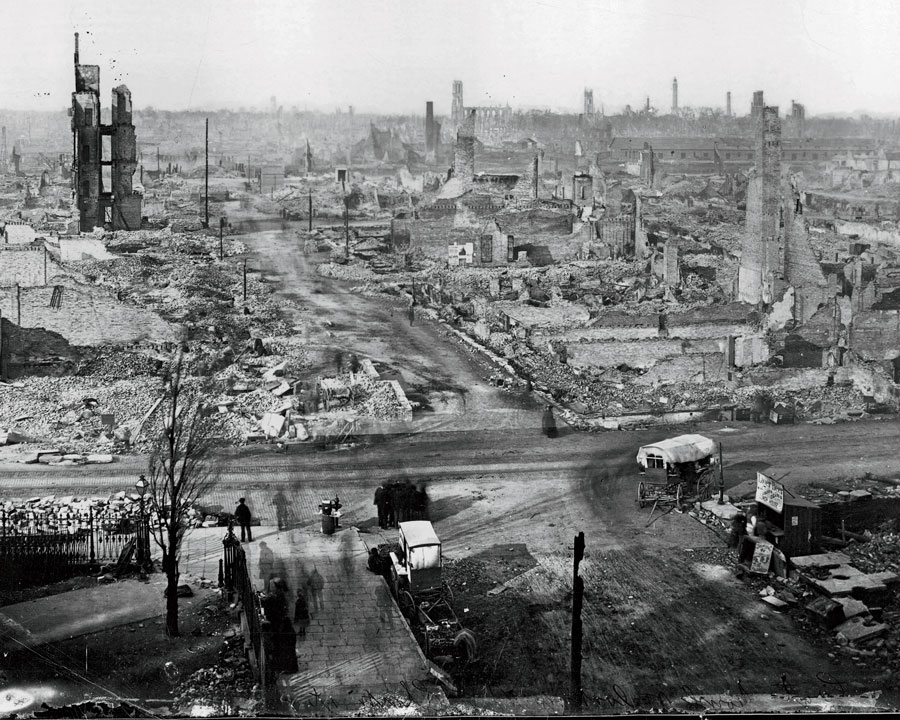
“Unmitigated fear took possession of me.”
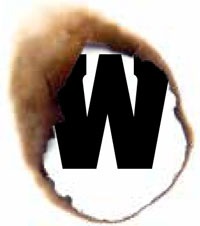 hile the fire moved farther north into the North Side, it continued to rage downtown before dawn on Monday. Adin Swan and his uncle fled in the same direction as many downtown residents: east toward the lake. At that time, the city did not extend as far east as it does today. Lake Michigan’s shore was just past Michigan Avenue.
hile the fire moved farther north into the North Side, it continued to rage downtown before dawn on Monday. Adin Swan and his uncle fled in the same direction as many downtown residents: east toward the lake. At that time, the city did not extend as far east as it does today. Lake Michigan’s shore was just past Michigan Avenue.
Swan: We went down to the Lake Park on Michigan Avenue, and I never saw such a sight in my life. The park is a mile long and about 200 feet deep. Every inch of it was covered with people and horses, buggies, pianos, tables, chairs, beds, clothing, silks, satin, jewelry, and everything that ever was in the city could be seen there. Men, women, and children with only their nightclothes on were running everywhere trying to find their relatives.
John McGreer, 31, a cartoonist and painter, lived on Dearborn Street near Washington Street.
McGreer: I was driven with nothing but my trunk to the breakwater on the lakeshore, and with 10,000 others hemmed in by the fire that extended nearly a mile south on Michigan Avenue — among the beautiful marble palace residences — and on the north by the tremendous flames from the Union Depot and those large [grain] elevators.
So intense had the heat become with large lighted cinders falling among the crowd, that it was almost suffocating. Hundreds of women fainted, and almost constantly some were getting crowded off the pier into the lake. I noticed a number of boys leap into the water with their clothes on to relieve themselves from the terrible heat and suffocation.
Mary Gookins, 55, wife of a former Indiana Supreme Court justice, lived on Wabash Avenue near Adams Street.
Gookins: Everybody on Wabash and Michigan Avenue carried all their goods that they could save to the little lakeshore park. There was no caste there then. Ladies in silk and velvets, diamonds gleaming here and there, and paupers in all their hideousness. Malicious groveling faces. Pure and saintly faces. All on a level, and a mighty devouring cloud of flames and smoke enveloping and covering them. Many had their clothes catch fire, and it required the utmost vigilance to keep from burning. The grass was like tinder, and it did seem as though the very earth was on fire.
As they left their Ohio Street home, Lambert Tree and his family were trapped by fire on three sides. They too had only one direction to escape. They ended up on a stretch of lakeshore known as the Sands, which had been a brothel district until city officials cleared it out in 1857. The Peshtigo Company lumberyard stood at the south end of the Sands, and Lill’s Brewery was burning to the north. At that time, the lakeshore was roughly where Fairbanks Court is today. Del and Gus Moore were among the people gathered on the Sands.
Tree: We had scarcely got out of the door before we were assailed by a hurricane of smoke, sparks, and cinders, which nearly blinded and suffocated us. Fearing separation, I grasped my wife by one hand and my son by the other. The skirt of my wife’s dress took fire as we went through the flames, and I tore it off. We hastened eastward along Ontario Street. Looking behind me, everything was enveloped in clouds of smoke and sparks, and here and there a neighbor’s house was in flames.
When we arrived on the lakeshore, we found thousands of men, women, and children, and hundreds of horses and dogs, who had already fled there for refuge. The grounds were dotted all over at short intervals with piles of trunks, chairs, tables, beds, and household furniture of every description. We stood among the crowd, watching the fire as it advanced and gradually encircled us, until the whole city in every direction, looking north, west, and south, was a mass of smoke and flames.
Moore: The cry came: “The lumberyard is on fire!” Black smoke sparks and cinders enveloped us. The wind increased, straw beds, feather beds, and blankets blazed, and even the people were on fire. One man passed us with his coat and vest all in a blaze, and he did not know it till someone called to him. For the only time, unmitigated fear took possession of me. I begged Gus if I took fire to put me in the lake and drown me, not let me burn to death.
Tree: Some persons drove their horses into the lake as far as the poor beasts could safely go, and men, women, and children waded out and clambered upon the wagons to which the horses were attached, while the lake was lined with people who were standing in the water at various depths, from their knees to their waists, all with their backs to the storm of fire which raged behind them. We remained in this position several hours.
Moore: What was even worse than the smoke was the driving burning sand, cutting us like needlepoints and putting our eyes nearly out. We watched each other that we should not burn. I was on fire three times but smothered the flames. For a moment there would be a pause, then the hot air coming, we would pant and gasp for breath till we would feel we could bear no more, when there would be a momentary breathing time.
Most of the people were composed. No one complained but all worked when there was work to do and endured when endurance was necessary. I was sitting on the sand when a poor colored girl threw herself on her knees beside me and held me tightly, saying beseechingly, “Will the lake dry up?”
I said “no” soberly. Then she said, “Do you think we will be saved?” I said what I did not believe, “We will surely be saved,” and she got up radiant, and I believe it saved her.
For a time, Moore became separated from her husband and a neighbor named Grew.
Moore: I found them, half-covered in sand and nearly invisible. Grew’s face was purple with suffocation and not able to speak. Gus did moan out something. A man threw me a basin and I ran into the lake and filled it, and I wet their faces and lips till they revived.
“They stumbled and fell from exhaustion.”
No newspapers were published in Chicago on the morning of Monday, October 9. The fire had destroyed downtown newspaper offices, including the Chicago Tribune’s purportedly fireproof building at the southeast corner of Dearborn and Madison Streets, which was constructed in 1869 out of limestone, marble, and brick.
The U.S. government’s weather observer reported that the wind “was blowing with the force of a hurricane” that morning in the fire’s immediate vicinity, lifting up entire wooden buildings on the North Side while they were ablaze. Wind currents were “blowing in all directions toward the fire.” With the city’s water supply drained, the fire department was virtually powerless to do anything — other than pump water out of the river and lake to spray it at nearby buildings.
Williams: I was completely tired out and wet to the skin. I jumped in my wagon and drove up to where my wife was and changed my clothes and drank a cup of tea and had two bites of bread, and I couldn’t swallow it. Then I went up on the North Branch and got the Coventry [fire engine] and put her across the river and led up there where there was a pile of tan bark burning. It was near some bridge. I have forgotten what bridge it was. I was pretty well racked. I was tired out.
Maurice “Sandy” Shay was foreman of the Titsworth fire engine.
Shay: I was just about blind. I couldn’t see where I was going, my eyes were so full of dust. A friend, who is an engineer on the railroad, told me to jump on his engine. I then went home, being so blind that I could not do any more service. I was physically played out.
Musham: The men had worked till their eyes were puffed out from heat and cinders, their voices were gone, and the clothing was burned off them. They felt their way from place to place, for they could not see. They stumbled and fell from exhaustion, and even then crawled to the front and fought on. And people say they were drunk. I tell you I never saw a drunken fireman that day. I’ve said that a hundred times, and it’s true.
Around 9 a.m., Detroit’s mayor received a telegram from Chicago’s mayor: “Send us food to the suffering. City in ashes.” The mayor of St. Louis received a similar message at 10 a.m. In cities across the country, crowds gathered outside newspaper and telegraph offices for the latest news about Chicago’s disaster — and people donated money, food, and supplies. Firefighters and fire engines began arriving in Chicago on trains from Milwaukee, Detroit, Pittsburgh, and Bloomington, Illinois.
While the fire continued to spread northward, its southern edge was also expanding to the luxury homes of Terrace Row, on Michigan Avenue between Van Buren and Congress. Tribune Company president William Bross, 57, who had served as the state’s lieutenant governor in the 1860s, lived where the Fine Arts Building now stands.
Bross: Having got out all we could, I sat down by my goods, which were piled up indiscriminately on the lakeshore. Soon I saw the angry flame bursting from my home. Quickly and grandly they wrapped up the whole block, and away it floated in black clouds over Lake Michigan.
Former alderman James Hildreth led efforts to halt the conflagration’s progress by exploding buildings with gunpowder to create a firebreak. By midday, demolitions south of Terrace Row stopped the fire’s advance in that direction. Horace White, 37, a Tribune editor, lived nearby.
White: We heard loud detonations, and a rumor went around that buildings were being blown up with gunpowder. The reverberations gave us all heart again. Think of a people feeling encouraged because somebody was blowing up houses in the midst of the city, and that a shower of bricks was very likely to come down on their heads!
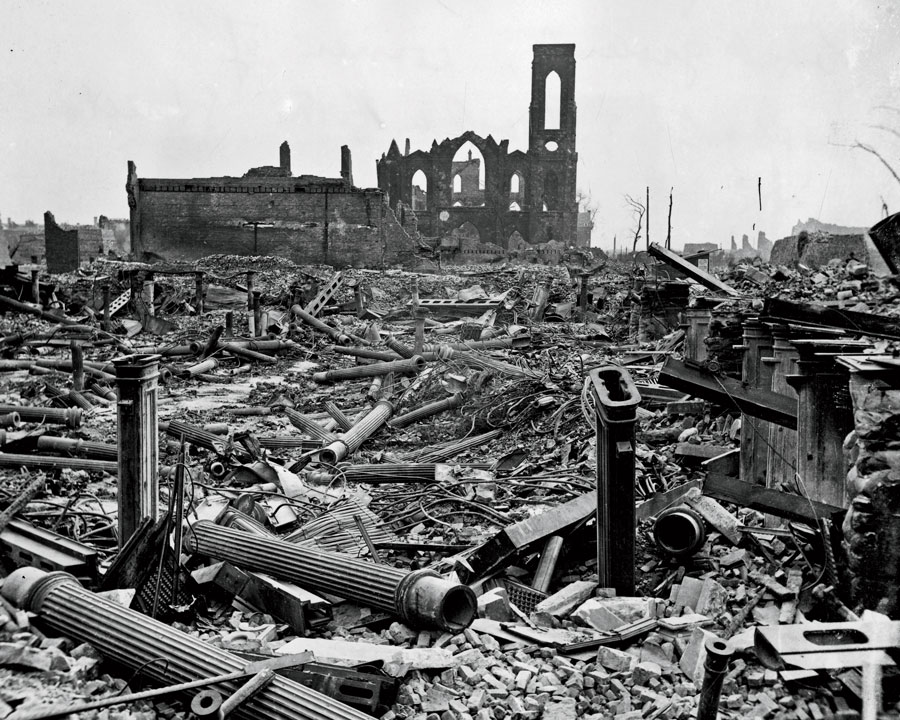
“On, on we ran,
not knowing
whither we went.”
Aurelia King was among many fleeing north into Lincoln Park, which was gradually being transformed during those years from the old City Cemetery into a space for leisure and recreation. At that time, Fullerton Avenue was the city’s northern boundary.
King: On, on we ran, not knowing whither we went till we entered Lincoln Park. There among the empty graves of the old cemetery, we sat down and threw down our bundles until we were warned to flee once more. The dry leaves and even the very ground took fire beneath our feet.
Julia Lemos, 29, a lithography artist, lived on Wells Street near North Avenue with her parents, Eustace and Johanna Wyszynski. Her husband had died in 1870, and the working mother was struggling to care for her five children. She’d recently placed the four oldest in the Chicago Nursery and Half Orphan Asylum, while keeping the youngest at home.
Lemos: About 5 o’clock in the morning I was woke up by a rumbling noise. I got up and threw open the shutters. I thought I was dreaming — the whole street was crowded with people, with hats and shawls on. A neighbor who stood in front of our house called to me, and said, “Mrs. Lemos, are you just getting up?”
I said, “Yes, what is the matter?” The sky was reflecting fire. She said, “The city has been burning all night, and the fire is coming to the North Side.”
Well, that startled me, and I ran to the back room and called my father and mother up. I said, “The city is burning.”
Father ran around shaking his hands. “The children, the children, I must go for them,” he said. I said, “No, you do not know where the asylum is. I will go. You stay here and take care of Mother and the baby.” Then I ran to the asylum. The matron said my children would be all right, and wanted me to leave them, but I insisted on taking them.
I wanted to leave the house, but Father said, “O, the wind will change.”
People were running in crowds past our house. I stood with my baby in my arms and the other children beside me, when a woman running past with three children said to me, “Madam, ain’t you going to save those children?”
I went to Father and said I was going to leave at once. He said, “O, wait.” But I started, and then he and Mother gathered some things.
The fire was threatening the neighborhood west of the park, which was also becoming known as Lincoln Park. Patrick Webb, 58, an Irish immigrant working as a day laborer for the Chicago & North Western Railroad, lived with his wife and three children in a frame house he’d built on Church Street (now Hudson Avenue).
Webb: We rose at the usual hour and went to our work. About 10 a.m. the foreman told me that the North Side was in danger and told me to go home. I did so, and found the fire was still a mile away from where I lived.
Soon after, the word was passed that Chicago Avenue bridge and the distillery near it were on fire, and the wind blowing a gale from the south soon spread the fire. All the loaded wagons that crowded Church Street hastened north to the prairie, and I sent my son to try and get a wagon at any cost. But it was too late. There was none to be had for love or money.
I saw some poor men digging pits in the ground and putting their little household property in them, so I thought I would do the same. And three of us went to work as hard we could and dug a pit about three feet deep by three wide till the water stopped us.
And while the women were filling that, we were digging another. And so on, till every article of furniture, bedding, clothing, and utensils were in the ground and covered. But unfortunately, they were not half-covered, for we had not time.
The sparks and burning brands were then falling around us, blown by the strong wind, and we had to escape for our lives. I asked my wife to give me my clothes to put on, as I had nothing on but my underclothes, overalls, and overshirt. But to my surprise, she told me she did not see them — but supposed they were in the pit, and covered up with the other things.
We then went north about half a mile where there were no houses to burn.
A reporter for the Evening Wisconsin, a Milwaukee newspaper, took a train to Chicago that day, later signing a dispatch with the initials F.A.M.
F.A.M.: We passed miles of fence, and fields, and woods on fire, 10 or 20 miles north from [downtown Chicago]. Five miles out, dense masses of smoke, with tongues of flame, were seen enveloping the whole north of the city. Two and three miles out, teams of household goods were streaming in all directions. Every street and square and corner in the outskirts of the city were piled with furniture, around which crouched despairing families.
I have seen a thousand families stretched along fences and yards, with the women holding children in their arms, and men and larger children stretched upon the ground. “I wish I was dead,” sobbed out one poor woman alone and desolate with her child.
After walking miles north from downtown, telegraph operator Gilbert Merrill approached open land on the city’s outskirts.
Merrill: We reached the prairie. Before us were thousands and thousands of human beings of all kinds, classes, and nationalities, some crying, some sitting on perhaps a small trunk — all they had — with their heads bowed on their hands in a terrible state of depression. We met a family who were once aristocratic wealthy and who had never known want or suffered poverty, but there on that broad prairie, they were cast homeless and poor with starvation staring them in the face.
I looked toward the fire, which seemed like a sea of fire, for one mile wide it was, nothing but flames leaping hundreds of feet in the air — horrible, horrible. We managed to get along, the flames lighting up the whole prairie and we could see for miles around. We came up to a crowd who were keeping the wind and dust off from a poor creature who had been burned most horribly — large blisters, as large as your hand, were all over his breast and face. I looked but a moment at the poor man, who was moaning most bitterly.
Lemos: We started away with the crowd and went way up north till we came to prairies, where people had moved their goods. It was getting late in the afternoon. The children were very tired, as we all were. Father took the mattress and laid the children on it and the feather bed and covered them with his large cloak. They got asleep for about an hour, when word came that we would have to run again.
The fire was on us, the wind blew the blazing boards for a long distance and set fire to all the goods on the prairie. I had to wake the children up, and we had to run again, and leave everything to burn. This time we felt the heat on our backs when we ran, like when one stands with the back to a grate fire.
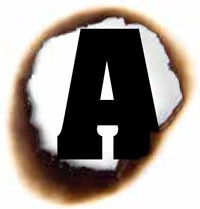 few Chicago newspapers managed to publish on Monday afternoon or evening. The Chicago Evening Journal’s extra was printed on just one side of one sheet, with a headline proclaiming: “The Great Calamity of the Age! Chicago in Ashes!!” The newspaper reported that the fire was “caused by a cow kicking over a lamp in a stable in which a woman was milking.”
few Chicago newspapers managed to publish on Monday afternoon or evening. The Chicago Evening Journal’s extra was printed on just one side of one sheet, with a headline proclaiming: “The Great Calamity of the Age! Chicago in Ashes!!” The newspaper reported that the fire was “caused by a cow kicking over a lamp in a stable in which a woman was milking.”
“That Monday night
was a fearful one.”
Swedish immigrant Charlotte Forsberg, 25, spent Monday fleeing from the fire with her husband — who was recovering from typhoid — and their two sons, ages 1 and 3. After stopping for short rests at various places, they finally went into a church.
Forsberg: When we got there, it was full. People were lying around the walls, some on bedding and some on the bare floor, but no one had gone inside the altar. I went in there. There was a carpet on the floor, and I got some of the seat cushions. When we lay down, away from the crowd, and I knew I had my husband and children safe, I felt so rich — I have never in my life felt so rich.
John DeKoven, 37, was a bank cashier.
DeKoven: That Monday night was a fearful one. The whole city was lighted up by the still burning ruins, and hardly anyone slept, as we none of us knew how quick we might have to run for our lives, for [had there been] a change in the wind from south to north at that time, there would have been nothing left of Chicago.
Many Chicagoans believed arsonists were setting fires, and city officials on Monday had deputized special police officers “for the maintenance of the peace and the protection of property.” Authorities and historians later said the rumors about arsonists were unfounded.
Stafford: I could not sleep, for these wretched creatures called men were setting fire to the city in all directions. The citizens were patrolling the streets, and orders were given to shoot down every man found setting fire to a building. I heard shot after shot, and felt glad when I heard them, for I knew that one of those fiends had been sent to last account.
Lemos: We ran a good way north, then Father thought we were safe and we stopped. Then the sky was clouding up and getting dark. There was an old board fence where we were. And Father pulled four boards off and laid them on the grass and laid three of the children on them and covered them with his large cloak again. But my oldest child, a boy about 9 years old, stayed with me.
I set on the grass holding the baby, and the boy laid his head on my lap and went to sleep. Then it was dark, and from where I was sitting, I could see a circle of fire at a distance. Then I saw a church steeple topple over in the flames. Just then, my boy woke up and began to sob. I said, “Willie, Mama is here, do not cry.” He said, “Yes, but Mama, isn’t this the last day?” You see, he had been to Sunday school and heard about the day of judgment — the end of the world.
Early the morning of Tuesday, October 10, rain began to fall, and the conflagration was halted at last. But the rain also threatened the health of thousands of Chicagoans camped outdoors. Del and Gus Moore were still at the Sands.
Moore: I felt a drop of rain on my face. In a moment all were awake to the fact that it was raining and we were without shelter. We were lying close to a stone wall that ran down to the lake. The boys went down to the lumberyard and got some boards, charred on one side, which they braced against the stone wall making a shelter, and under those we crawled, lying closely packed the rest of that long night. We did not groan or cry, but took what comfort we could. The ground was hard and cold, but it was a rest.
Lemos: Then it began to rain, a pouring rain. I said to Father, “It will kill those children to sleep in that rain.”
Poor old man, he said, “I have done all I can.”
I said, “I think this is a farm, or this fence would not be here. I will go see if there is not a shed we might go in out of the rain.”
Father said, “You must not go; I will.” Soon he came back and said he had found a shed. I had to wake the children up, and we all went to the shed.
Of course, it was pitch dark inside, and we did not know if there were cows or pigs or dogs there, and not one of us had a match. Mother and I sat flat on the ground, each with a baby in our arms. Then we tried to sleep, as we were all worn out. About midnight, I was roused, and saw two figures coming in, but it was so dark we could not see who it was. At the first rays of daylight, I saw it was a poor woman with her little boy.
Some Chicagoans found shelter in the homes of friends or strangers in neighborhoods and suburbs beyond the burning region. After fleeing downtown, the Tribune’s Horace White stayed at a friend’s home in the south suburbs.
White: There was no sleep for us until we heard the welcome sound of rain against our windows. How our hearts did rise in thankfulness to heaven for that rain! We thought the poor people in Lincoln Park would rather have the rain on their heads than know that Chicago was exposed to the horror of total conflagration.
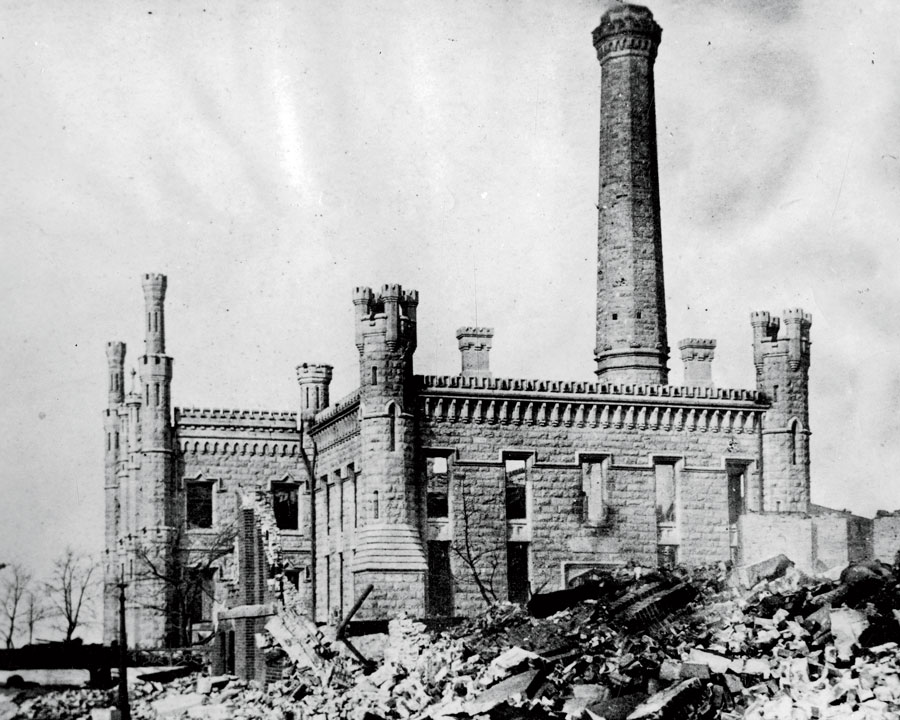
“Chicago must and shall be rebuilt at once.”
On that Tuesday, Chicagoans began taking stock of what had been destroyed and what remained of their city. Patrick Webb and his family had spent the night huddled next to a fence.
Webb: About 5 o’clock next morning, [the] Lutheran church was opened to admit the shivering crowd, which soon filled it — and right glad to get the shelter. We were told they were giving some provisions to those that had none. I got a little bread and meat. It was then I felt real bad, for I considered myself a beggar.
I left my family in the church and hurried off to where my house stood. It was very difficult for me to find the place, as there was nothing left to mark the spot where the house stood. When I did find it, I saw smoke issuing from the pits where all that we possessed in the world was buried.
I felt broken down in spirits seeing all that I had saved during my life, about $1,500, by hard labor, honesty and sobriety, swept away in a few hours — and I at the age of 58.
Moore: I did not sleep one minute and the night was long and morning came at last. By 7 Tuesday morning we were loaded into a truck wagon with all our worldly possessions, taking our way through the ruins of the beautiful North Side. Oh! The destruction that had taken place while we were shut in on the shore!
At Kinzie Street Depot we found we could get to Oak Park. Gus took me to the waiting room. Poor forlorn specimen that I was, covered with sand and dirt and smoke, I could bear it no longer. The tears rolled down my black face, which I buried in my shawl and sobbed aloud. The people gathered round me, and I cried on till I heard Gus say, “Don’t give up now, Del.” And looking up, I burst out laughing and said, “Boys, give me a handkerchief.”
Bross: While making my way through the crowd over the Madison Street bridge, desolation stared me in the face at every step, and yet I was much struck with the tone and temper of the people. On all sides I saw evidences of true Chicago spirit, and men said to one another, “Cheer up — we’ll be all right again before long,” and many other plucky things. Their courage was wonderful. Everyone was bright, cheerful, pleasant, and even inclined to be jolly, in spite of the misery and destitution which surrounded them, and which they shared. One and all said, “Chicago must and shall be rebuilt at once.”
Tree: The telegraph wires lay curled and tangled upon the streets, and here and there was a dead horse, cow, or animal of some kind, which had been overtaken by the fire, and perished. I saw that morning, however, but one dead human body, and that was on Dearborn between Ohio and Ontario Streets. It was burned beyond recognition.
Stamm: On the North Side, we crossed the sites of many homes and saw the charred remains of many human beings who had perished in the fire, being unable to escape. Heads, arms, and legs had been consumed, and trunks were mere shrunken masses. These horrible sights so shocked me that for four to six weeks afterward, I dared not sit in a room alone. I heard the cries and saw the mutilated bodies of the dead always before me.
EPILOGUE
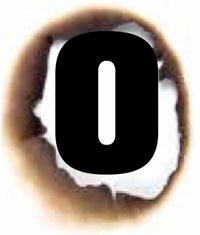 fficials and historians have made educated guesses about the death toll, placing it at 200 to 300. According to the coroner’s office, 117 bodies were found. “The exact number will never be ascertained,” journalists Elias Colbert and Everett Chamberlin wrote in an 1871 book about the fire. “The destruction was in many districts so complete that no vestige of a human body or skeleton would be discernible among the debris of consumed buildings.” Meanwhile, a forest fire that began on the same day as the Great Chicago Fire killed an estimated 1,100 people in the area around Peshtigo, Wisconsin, a lumber town that supplied wood to Chicago.
fficials and historians have made educated guesses about the death toll, placing it at 200 to 300. According to the coroner’s office, 117 bodies were found. “The exact number will never be ascertained,” journalists Elias Colbert and Everett Chamberlin wrote in an 1871 book about the fire. “The destruction was in many districts so complete that no vestige of a human body or skeleton would be discernible among the debris of consumed buildings.” Meanwhile, a forest fire that began on the same day as the Great Chicago Fire killed an estimated 1,100 people in the area around Peshtigo, Wisconsin, a lumber town that supplied wood to Chicago.
Tallies of the Chicago fire’s property damage run as high as $200 million ($4.4 billion today). Today, it ranks fifth on the National Fire Protection Association’s list of U.S. fires causing the most property damage — surpassed only by the 2001 attack on the World Trade Center, the fires caused by the 1906 San Francisco earthquake, and the California forest fires of 2017 and 2018.
Nearly one in three Chicagoans — close to 100,000 people — were left homeless. Although the fire started in the West Division, destroying 500 buildings there, it did the least damage in that region. The wind blew the flames north and east, away from the bulk of the West Side, and the burned area from the previous night’s blaze acted as a firebreak. Even the O’Leary family’s house survived.
The destruction was far worse in the South Division, where 3,650 buildings, including many of Chicago’s largest and most important structures, were leveled across the downtown district. And the conflagration virtually wiped out the entire North Division, destroying all but 500 of 13,800 buildings, including thousands of immigrant workers’ homes.
The Chicago Relief and Aid Society reported assisting 160,000 people during the fire’s aftermath. Its efforts included building barracks and small houses to shelter the homeless. But critics complained the private group was too stingy, showing class bias and prejudice against immigrants when it decided which Chicagoans were worthy of assistance.
Chicagoans died at a higher than normal rate during the two years following October 1871. The city’s excess mortality — the deaths above population-adjusted averages for prior years — was roughly 4,700, according to Chicago magazine’s calculation. The Chicago Board of Health suggested one reason so many people died: unhealthy living conditions in barracks and temporary housing.
A month after the fire, Chicago Tribune editor Joseph Medill was elected mayor, vowing to prohibit wooden buildings throughout the city. But many working-class Germans opposed his plan, saying they couldn’t afford brick homes. The City Council allowed those North Siders to build with wood, rejecting Medill’s proposal and approving a more modest policy prohibiting wooden buildings in a central zone. Eventually, aldermen did vote to ban all wooden construction — but only after another fire swept across 47 acres at downtown’s south end in 1874.
The 1871 fire gave Chicago its most enduring myth. Over and over, people told the story of how Mrs. O’Leary was milking her cow when it kicked over a lantern and set the city ablaze. But witnesses at the Police and Fire Commission had agreed that the O’Leary family was in bed when the fire began. In 1997, the Chicago City Council declared that city officials “do hereby forever exonerate Mrs. O’Leary and her cow from all blame in regard to the Great Chicago Fire.” That resolution was prompted by the research of Richard F. Bales, who later wrote The Great Chicago Fire and the Myth of Mrs. O’Leary’s Cow.
After analyzing property records and testimony, Bales pointed to the O’Learys’ neighbor Daniel Sullivan as a possible culprit. According to Bales, at least one building would have blocked Sullivan’s view of the O’Leary barn if he’d been sitting at the spot where he claimed he was when he saw the fire. Bales conjectured that Sullivan must have lied to cover up his own role in starting the fire, perhaps by smoking in the O’Leary barn.
In spite of Bales’s findings and the aldermen’s proclamation, the cause of the Great Chicago Fire remains the subject of theorizing and speculation. A definitive answer may be unknowable.
In the years after 1871, Chicago was hailed as a phoenix rising from the ashes. Rebuilding began as soon as the debris was cleared, and the disaster did not slow Chicago’s growth. Rather, it sped up the city’s modernization by offering a blank slate for new construction.
This revival would become integral to how Chicago defines itself. When Louis Sullivan arrived in Chicago in 1873, the 17-year-old architect heard people boasting about their city — as well as the catastrophe it had survived. “ ‘Big’ was the word,” he recalled in his autobiography. “ ‘Biggest’ was preferred, and the ‘biggest in the world’ was the braggart phrase on every tongue. Chicago had had the biggest conflagration ‘in the world.’ ” Gazing for the first time upon this burned and reborn city, Sullivan felt a “sense of big things to be done.”




